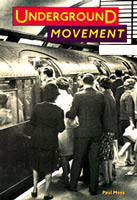Taking stock
Many books have been devoted to London Underground station architecture, but a volume on the rolling stock has been long overdue

I began reading this book heading west on the Central Line somewhere between White City and North Acton, at precisely the point where every evening the short commute home turns into a long day’s despairing journey into night.
As we shuddered to yet another halt, perhaps this was not the most auspicious place to start turning pages devoted to the glories past, present and future of London Underground’s rolling stock. But Underground Movement by Paul Moss actually provided welcome relief from having to eyeball morose fellow passengers straphanging in the half-light of a tatty Central Line train compartment in the first year of the 21st century.
How different it all seemed back in 1912, when 24 all-steel motorised cars with interior heaters were ordered from Brush of Loughborough for Central London Railways’ planned extension out to Ealing Broadway (they were delivered in 1917). What style and civility these trains promised.
In the years immediately following the end of the First World War – the years of London Transport design supremo Frank Pick – Tube train interiors sported polished magohany, leather armrests, silver oxidised fittings and Victoriana-style lights. Even later remodelling under Pick to standardise all products and services retained the integrity of the original designs.
I learnt all this from the ultimate train buff’s commentary supplied by Moss, who spent seven-and-a-half years as design manager of London Underground, and from the abundance of evocative black and white photography showing a super-confident era in design for London that Ken Livingstone and his new transport commissioner Bob Kiley will struggle to emulate. LT rolling stock of the 1920s and 1930s captured the idea of an expanding world city with a distinctive flair, American streamlining and Art Deco detailing, artfully incorporated into trains heading for Northfields and Rayners Lane.
Later, after 1945, came the first all-aluminium unpainted “silver trains” on the District Line, the first fluorescent lights on modernised Metropolitan Line trains, and those sets of facing transverse seats on the Piccadilly Line. The role of the design consultant began to make an impact, initially through Misha Black, founder of Design Research Unit, who involved students from the Royal College of Art in exhibiting new designs and laid the ground for industrial designers to work alongside LT engineers on new rolling stock projects. By the early 1980s, David Carter’s DCA design firm was proposing radical solutions with extensive glazing – fresh thinking, which fed into the development of new Central Line trains a decade later.
Moss brings the whole story bang up to date with a chapter on “the trains that never were” – dramatic concepts by Seymour Powell, Design Triangle, Jones Garrard, FM Design and others that hint at what might have been – as well as detailed accounts of various refurbishment projects that saw light at the end of the tunnel.
If he’s much more interested in the hardware of the Tube network than the changing demographics it serves, then at least he ends with Chris Sharp’s Space Train and Accessible Train proposals. These hint at a better future for passengers, especially disabled users.
So much publishing activity has been devoted to London Underground station architecture and graphic design that a volume on the rolling stock has been overdue for some time. Travelling on the Tube may hardly be a treat, but this book certainly is. Anoraks optional.
Underground Movement by Paul Moss is published on 14 December by Capital Transport Publishing in association with the London Transport Museum, priced £30. Jeremy Myerson is director of the Helen Hamlyn Research Centre at the Royal College of Art
-
Post a comment




